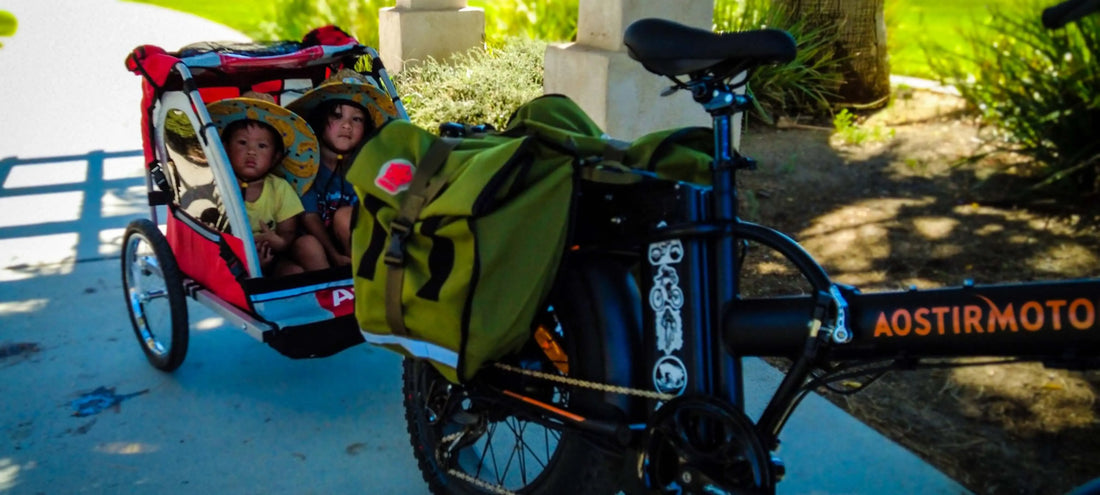Three Things You Need To Know About Riding With Kids

Riding an e-bike can be a great way to be alone, but it's also a great way to spend more time with your family. Riding with kids is a great family activity for you and your partner. Here are three things you need to know before you're ready to ride:
Choose the Right Bike
As children learn, grow and develop their skills, their needs for bicycles can change dramatically. So while one bike might be perfect for your 6-year-old, another, the bigger bike might fit your 8-year-old. Many parents and caregivers make the mistake of buying a bike that their child can "grow". While you may think that buying a giant bike will save you money, we recommend against it. For younger kids, larger bikes can make riding uncomfortable, complicated and dangerous.
Here are Some General Tips For Choosing the Best Bike for Your Child:
Ages 0-6: A bicycle seat or trailer is the safest way to introduce your child to cycling. When they're old enough, they may start to crave doing things on their own, and they can usually get off the trailer and ride with you on an attachable bike seat.
By the age of six: They may become too large to fit a bike seat. The balance bike will help your child focus on steering and balance, allowing them to ride safely on a training bike with pedals and brakes. Find the right light bike for your child to ensure they enjoy a fun and safe ride.
Get the Right Equipment

Proper cycling equipment will keep your child safe and happy on every trip. Some pointers:
Make Sure Your Child is Wearing a Helmet: Wearing the right bike helmet is the best way to prevent head injuries. Wearing a helmet to a child while riding a bike with them is often overlooked by parents. After all, too many adults already ride bicycles without proper head protection. But kids are especially vulnerable, especially since they don't drive a bike and can't control their own safety -- it's entirely in the hands of adults. That's why you should always equip your child with a children's bike helmet before riding. For children's bicycle helmets, the most important thing is to check that it is properly fitted and protects the forehead. When securing the chin strap, place your fingers under the chin strap to avoid over-tightening the strap or pinching your child's neck with the buckle.
Dress Appropriately For the Weather: Dressing for the weather not only keeps your kids dry and warm, but also keeps them safe. If it rains, make sure your child is properly dressed for riding in wet conditions. If it's cold outside, wear a nice coat, thick socks, mittens, and a beanie under your helmet. In cold weather, a ski mask is also a good idea.
Your Best Friend is Reflective Tape: Reflective tape on trailers, bikes and helmets lets other cyclists and motorists see your family, whether your kids are on a trailer or a bike. Adding safety signs to your trailer is also a good rule of thumb when it comes to family riding safety.
In Low Light, Adequate Lighting is Required: When your family is riding in low light, it's critical to utilize your bike's headlights and taillights to improve visibility and alert motorists when they're approaching you.
Please Bring Your Own Snacks: As any parent or childcare provider knows, kids get hungry at the most random times. Carrying food and drinks with you when traveling will keep everyone hydrated and energized - keep refreshments in a small basket to keep them safe throughout the trip.
Choose a Child-Friendly Route

If you're an experienced cyclist, you don't have to worry about where you're going as long as you're outside! However, let's say you want your child to keep riding. In this case, they must be interested in and involved in the family cycling experience and feel safe on the road. Here's how to make sure your kids have fun on every ride:
Before you go, check out the bike routes. Avoid excessively hilly terrain, busy roads and other obstacles that children cannot easily navigate. Plan your family bike trip to take advantage of safe, calm roads and bike paths. Checking the route allows you to prepare shortcuts in case your child gets tired quickly.
Don't go too far. Say you take your family on a long trip. In this case, your child may see it as overly complicated and responsible, leading to crankiness. Shorter routes will keep kids interested and encourage them to cycle more in the future.
If you have a very young child who uses a balance bike or training bike, a family ride on a sidewalk near you is usually your best option, unless your child can sit in a child bike seat or in a trailer.
Involving your kids in your favorite hobbies can build your relationship while improving their quality of life. Family bike rides are a fun, positive way everyone involved should have fun!

